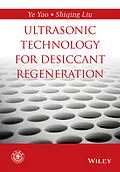The chapters in this volume explore ultrasound-assisted regeneration of silica gel, ultrasound-assisted regeneration for a new honeycomb desiccant material, ultrasound-atomizing regeneration for liquid desiccants, ultrasonic transducers, and much more.
Autorentext
Ye Yao and Shiqing Liu are the authors of Ultrasonic Technology for Desiccant Regeneration, published by Wiley.
Inhalt
About the Authors ix
Preface xi
Acknowledgements xiii
Nomenclature xv
1 Introduction 1
1.1 Background 1
1.2 Literature Reviews 2
1.2.1 Desiccant Materials 2
1.2.2 Types of Desiccant Dryer 4
1.2.3 Regeneration Methods 10
1.3 The Proposed Method 19
1.3.1 Basic Knowledge about Ultrasound 19
1.3.2 Sound Generation 22
1.3.3 Fundamental Theory for Ultrasound-Assisted Regeneration 24
1.4 Summary 26
References 26
2 Ultrasound-Assisted Regeneration of Silica Gel 33
2.1 Theoretical Analysis 33
2.2 Experimental Study 38
2.2.1 Experimental Setup 38
2.2.2 Procedure for Experiments 39
2.2.3 Methods 40
2.2.4 Results and Discussions 42
2.3 Empirical Models for Ultrasound-Assisted Regeneration 51
2.3.1 Model Overviews 51
2.3.2 Model Analysis 52
2.4 Theoretic Model for Ultrasound-Assisted Regeneration 59
2.4.1 Physical Model 62
2.4.2 Mathematical Model for Ultrasonic Wave Propagation 62
2.4.3 Mathematical Model for Heat and Mass Transfer in Silica Gel Bed 67
2.4.4 Model Validation 75
2.4.5 Error Analysis for Experimental Data 85
2.5 Parametric Study on Silica Gel Regeneration Assisted by Ultrasound 89
2.5.1 Acoustic Pressure and Oscillation Velocity in the Packed Bed 89
2.5.2 Thermal Characteristics of the Bed during Ultrasound-Assisted Regeneration 91
2.5.3 Enhancement of Regeneration Assisted by Ultrasound 106
2.5.4 Comparisons between the Transverse- and Radial-Flow Beds 110
2.6 Quantitative Contribution of Ultrasonic Effects to Silica Gel Regeneration 110
2.6.1 Theoretical Analysis 110
2.6.2 Method 113
2.6.3 Results and Discussions 114
2.7 Energy-Saving Features of Silica Gel Regeneration Assisted by Ultrasound 119
2.7.1 Specific Energy Consumption 119
2.7.2 Results and Discussions 120
2.7.3 Brief Summary 125
2.8 Effects of Ultrasound-Assisted Regeneration on Desiccant System Performance 126
2.8.1 Study Objective and Method 126
2.8.2 Results and Discussions 127
2.8.3 Brief Summary 139
References 139
3 Ultrasound-Assisted Regeneration for a New Honeycomb Desiccant Material 141
3.1 Brief Introduction 141
3.2 Experimental Study 142
3.2.1 Experimental System 142
3.2.2 Raw Material and Experimental Conditions 142
3.2.3 Analysis Parameters 144
3.2.4 Experimental Results 145
3.2.5 Energy Attenuation and Absorptivity of Ultrasound in the Material 154
3.3 Theoretical Model for Honeycomb-Type Desiccant Regeneration 159
3.3.1 Basic Assumptions 159
3.3.2 Governing Equations 159
3.3.3 Determination of Key Parameters 160
3.3.4 Model Validation 161
3.4 Model Simulations and Analysis 163
3.4.1 Parametric Study 163
3.4.2 Quantitative Contributions of Ultrasonic Effects to the Regeneration of Honeycomb-Type Desiccant 172
3.5 Summary 176
References 176
4 Ultrasound-Atomizing Regeneration for Liquid Desiccants 177
4.1 Overview 177
4.1.1 Principles and Features of the Liquid-Desiccant Dehumidification 177
4.1.2 Thermo-Physical Properties of Liquid Desiccant Materials 178
4.1.3 Research Status of Solution Regenerators 182
4.2 Theoretical Analysis 183
4.2.1 Mass Transfer Coefficients for the Droplets 183
4.2.2 Atomized Size of Droplet by Ultrasonic Atomizing 192
4.2.3 Droplet Distribution Characteristics and Measurement Techniques 194
4.2.4 Vapor Pressure of Liquid Desiccant Mixture 196
4.3 Theoretical Modeling for the Ultrasound-Atomizing Regenerator 201
4.3.1 Assumptions 201
4.3.2 Basic Equations 201
4.3.3 Determination of Key Parameters 202
